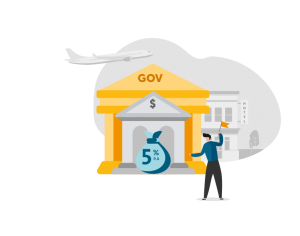Temporary Bridging Loan Programme (TBLP) to provide access to working capital for business needs
By: Hitesh Khan/
As announced at Supplementary Budget 2020, eligible enterprises may borrow up to $5 million under the Temporary Bridging Loan Programme, with the interest rate capped at 5% p.a., from Participating Financial Institutions (PFIs). The Government will provide 80% risk-share on these loans.

Eligible enterprises under the Temporary Bridging Loan Programme may also apply for up to 1 year deferral of principal repayment to help manage their debt, subject to assessment by the PFIs.
Table of Contents
The Temporary Bridging Loan Programme started in March 2020, and is available until 31 March 2021. Interested enterprises can apply directly to the PFIs.
|
MAXIMUM LOAN QUANTUM
|
S$5 Million / Borrower Group1 |
|
MAXIMUM REPAYMENT PERIOD
|
5 years |
|
RISK-SHARE
|
The borrower is responsible to repay 100% of the loan amount. When defaults occur, the PFIs are obligated to follow their standard commercial recovery procedure, including the realisation of security, before they can make a claim against Enterprise Singapore for the unrecovered amount in proportion to the risk-share |
|
INTEREST RATE
|
Capped at 5% p.a. |
1 Borrower Group consists of the following:
| a. | Borrower; and |
| b. | Corporate shareholders that hold more than 50% of the total shareholding of the applicant company, and any subsequent corporate parents (all levels up), and subsidiaries all levels down. (Annual sales turnover and employment size is computed on a group basis.) |
Eligibility for Temporary Bridging Loan Programme
- Be a business entity that is registered and physically present in Singapore. (ACRA registered Sole Proprietorship, Partnership, Limited Liability Partnerships and Companies are eligible to apply for the Temporary Bridging Loan. Approval of the loan is subject to the PFI’s assessment.)
- At least 30% local equity held directly or indirectly by Singaporean(s) and/or Singapore PR(s), determined by the ultimate individual ownership.
What Is Bridging Loan?
Bridging loan is also a short-term financing option. However, the main purpose of bridging loan is to ‘cover’ (or bridge) the gap between an incoming debt and the time till your credit is ready.
How Does Bridging Loan Work?
The best way to explain how a bridging loan works is by giving an example. So, imagine if you just sold your house. It will take a while before you receive proceeds from the sale, isn’t it? But what happens if you need the money to pay for your down payment to purchase your new home? This is where bridging loan can come in and help to pay for your new home while you wait for sales proceeds from your existing property.
What Is The Duration Of Bridging Loan?
Since bridging loan is a type of short-term financing, the bank/financial institution will generally offer you 6-12 months of loan period. You will need to fully repay the loan after a relatively short period.
2 Types Of Bridging Loan: Capitalised Interest Bridging Loan & Simultaneous Repayment Bridging Loan
Capitalised Interest Bridging Loan
Under the capitalised interest bridging loan, the bank/financial institution will finance your new home (up to 80%). Once the sale of your current property is completed, the repayment of the bridging loan will start. Interest will be accrued and payable to the bank/financial institution for the whole period of your bridging loan.
Simultaneous Repayment Bridging Loan
But even if you haven’t sold your property yet, you can still take a bridging loan. This is the purpose of the simultaneous repayment bridging loan. The simultaneous repayment bridging loan is for homeowners who have the intention to sell off your current property. But you might not have found a suitable buyer yet. In such cases, you can take the simultaneous repayment bridging loan to pay for your new home while continuing to pay off the home loan for your current property. The bank/financial institution will likely give you up to 12 months to sell off your property. After which, you will need to repay your bridging loan once you receive the sales proceeds.
What Do You Need To Qualify For A Bridging Loan?
In order to qualify for a bridging loan, you will need to show proof that you are waiting for sales proceeds from your previous property. This can work by providing the Option to Purchase (OTP) agreement document that is signed by the buyer.
Is Bridging Loan Only Limited To Private Property Owners?
Bridging loans do not have a specific target audience. Regardless of whether you are a private property or HDB owner, you will be able to apply for a bridging loan as long as you have the OTP agreement for your current property. It also doesn’t matter whether the property you are selling away is an HDB or private property.
Where Can You Get A Bridging Loan?
Bridging loans are offered by most financial institutions and banks in Singapore. Typically, if the bank or financial institution offers home loan, it will also offer bridging loan to you.
For bridging loan, the interest rate payable is pretty stable across the industry. Banks and financial institutions are likely to offer very similar interest rates to each other. Bridging loan can help you in your bid to become a multi-property owner? Get in touch with iCompareLoan where our loan specialists will show you how to leverage on bridging loan in your second property purchase.
A good place to start looking for temporary bridging loan is with loan consultants. Loan consultants have good links with multiple lenders and can help you lend the best deals with the lowest interest rates. The services of loan consultants are usually free – which is why you should not hesitate consulting one.





